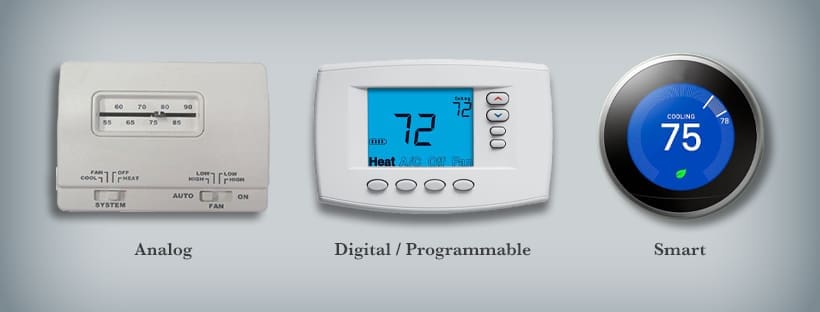In today’s market, there are some fantastic options for thermostats that can perform impressive feats, such as reacting to weather forecasts, learning your preferences, and even detecting whether you are home. These features are quite advanced, but do they qualify as “smart” devices within a smart home? Let’s break it down.
We will explore five types of thermostats and explain the intelligence level of each one:
1. Old School Thermostats
The plain old “dumb” thermostat only reacts to an internal mercury switch to turn on/off. These are still very common in tract and manufactured housing, apartments, commercial buildings, and secondary buildings like garages and outbuildings. This reliable thermostat maintains the set temperature but requires manual adjustments for any changes. People often find a comfortable temperature and leave it there for months, regardless of whether the home is occupied. This is why many people replace these thermostats with more advanced types.
2. Digital/Programmable Thermostats
The next step in thermostat intelligence is the digital/programmable thermostat. These are replacing old-school thermostats because they allow you to set specific temperatures and program different settings for various times and days. Initially, people found these revolutionary as they could turn off heating or cooling when the house was empty. However, many don’t take the time to program them properly. Like old VCR clocks that flashed noon after power outages, people often set these thermostats once and then leave them on a continuous “hold,” making them digital versions of old-school thermostats.
3. Connected Thermostats
The next level of intelligence is a “connected” thermostat. These thermostats connect to your Wi-Fi network and may grab weather data from the internet, but their main benefit is moving control from the wall to a smart device, usually a smartphone. This eliminates the need to get up and adjust the thermostat manually, giving you all the information and controls you need in an app. It’s like the first remote control for your thermostat, arriving decades after TV remotes. People love these because they can make adjustments without leaving the couch or bed. Many also include Alexa, Google, or Siri integration, adding voice control to the remote functionality.
4. Intelligent Thermostats
Intelligent thermostats build on the remote control function of connected thermostats by adding some programming to act semi-autonomously. These are not only Wi-Fi connected but also internet-connected, allowing them to bring in weather and other data from numerous sources and make decisions based on that data. For example, you may have an ‘evening mode’ for the thermostat to enter, but as the sun sets earlier and earlier in winter, the start time of that mode needs to change to maintain the desired temperature throughout the evening. Intelligent thermostats typically collect data using a geofence for a device, usually a smartphone, carried by home occupants. This determines if the home is occupied – if a device is inside the geofence, then someone is at home, and the temperature should be set accordingly. If no devices are within the geofence, the house is unoccupied, so the temperature should adjust accordingly.
5. Smart/Brilliant Thermostats
A smart/brilliant thermostat does more than just track the weather and your phone’s location. It interacts with other devices and sensors in your home to make decisions. For example, it uses your security system’s status to determine if the house is occupied and what mode it should be in – armed away, armed night, or disarmed. It also uses motion detectors to see if a space is being used and adjusts the temperature accordingly. If no one has been upstairs for a day, it adjusts the temperature until it detects motion.
Conclusion
As you can see, there are solid arguments for upgrading from an old-school thermostat. When building a smart home, consider investing in a smart/brilliant thermostat that can react to other systems in your house, elevating your home’s intelligence to a new level.


No responses yet